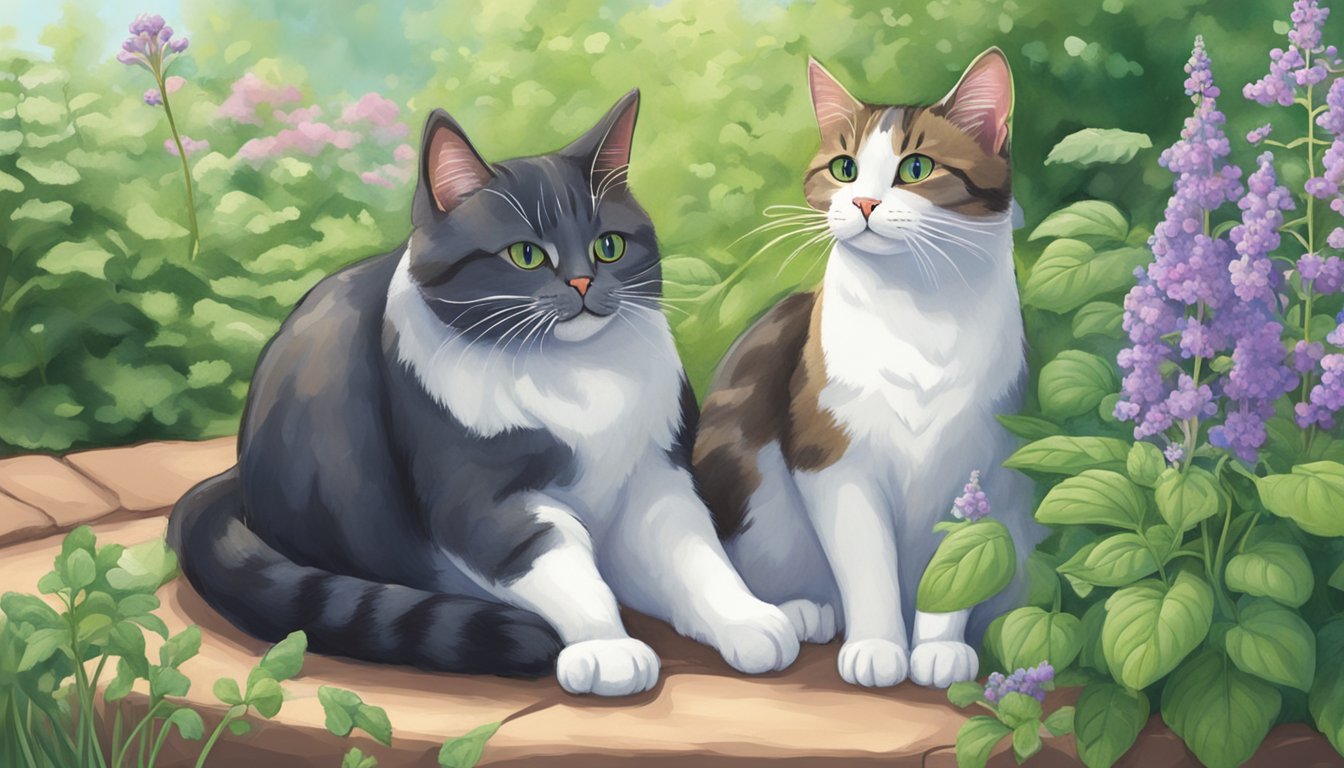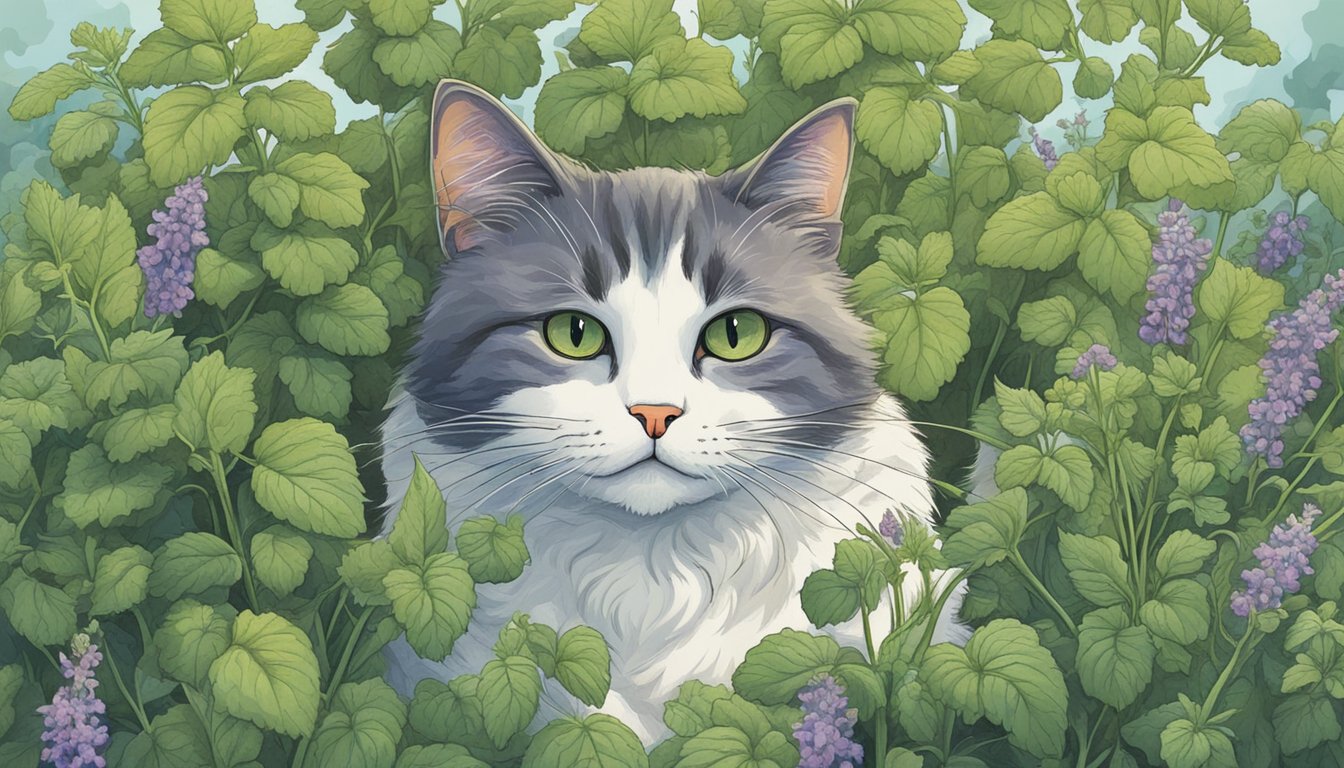Catmint vs catnip – two plants often confused with each other. Both belong to the Nepeta genus and the mint family. They share similar features, like their leaves and flowers. However, there are distinct differences worth noting. Let’s explore these fascinating plants!
Catnip, also known as Nepeta cataria, is a perennial herb that is native to Europe and Asia. It is a low-growing plant that produces small white flowers and has a weedy appearance. Catnip is well-known for its effects on cats, as it contains a compound called nepetalactone that can cause cats to become excited and playful. However, it is also used for medicinal purposes in humans, as it has been shown to have mild sedative and anti-anxiety effects.
On the other hand, catmint is a more ornamental plant that is often grown in gardens for its attractive flowers. It comes in several different varieties, such as Nepeta mussinii and Nepeta racemosa, and produces lavender or purple flowers. Unlike catnip, catmint does not have the same effects on cats, although it is still a member of the mint family and has a similar scent and flavor.
What Is the Difference Between Catmint Vs Catnip?
As a cat owner or gardener, you might have heard of catmint and catnip. While they share some similarities, they are different plants. In this section, I will discuss the differences and similarities between these plants.
Similarities (Genus Nepeta, Square Stems)
Both catmint and catnip belong to the Nepeta genus, which includes about 250 species of plants. One of the defining characteristics of this genus is the square stems. This feature is useful in identifying plants in the Nepeta genus.
Differences (Use for Cats vs Ornamental Use, Appearance)
The most significant difference between catmint and catnip is their use. Catnip is famous for its effect on cats, while catmint is grown mainly for its ornamental value. Catnip is a herb that attracts cats because of the compound nepetalactone found in its leaves and stems. On the other hand, catmint is grown for its attractive flowers and foliage.
Another difference between the two plants is their appearance. Catnip has a weedier appearance, while catmint is often used as a pretty, flowering perennial in beds. Catmint flowers more continuously than catnip, and its flowers are lavender. Catnip flowers, on the other hand, are typically white.
In summary, while catmint and catnip share similarities, they are different plants. Catmint is grown mainly for its ornamental value, while catnip is famous for its effect on cats. Knowing the differences between the two plants can help you choose the right plant for your garden or your feline friend.
How to Grow Catmint Vs Catnip

Where to Plant
Both catmint Vs catnip are easy to grow perennial plants that belong to the Nepeta genus. They prefer full sun and well-drained soil, making them perfect additions to any garden or landscape. They can be grown in containers as well, making them a great option for those with limited space.
When selecting a location to plant your catnip or catmint, consider the hardiness zones in your area. Catmint Vs catnip grow well in USDA hardiness zones 3 to 9. If you’re unsure about the hardiness zone in your area, consult with your local nursery or garden center.
Growing Tips
Catmint Vs catnip are both easy to grow and require minimal maintenance. Here are some tips to help you grow healthy and vibrant plants:
- Water your plants regularly, but be careful not to overwater them. Catmint Vs catnip prefer well-drained soil, so make sure the soil is not waterlogged.
- Fertilize your plants once a year in the spring with a balanced fertilizer.
- Prune your plants regularly to encourage bushy growth and prevent them from becoming too leggy.
- Catmint Vs catnip are perennials, which means they will reseed themselves. To prevent overcrowding, divide your plants every few years.
- Catmint Vs catnip produce white or purple flowers, which are a valuable source of food for pollinators. Deadhead your plants regularly to encourage continuous blooming throughout the growing season.
Growing catmint Vs catnip is easy and rewarding. With a little bit of care and attention, you can enjoy these beautiful and fragrant plants in your garden or landscape for years to come.
Effects of Catmint Vs Catnip on Cats

As a cat owner, you may have heard about the effects of catmint Vs catnip on cats. Both plants belong to the mint family and contain a chemical called nepetalactone, which is known to stimulate cats and give them a euphoric high. However, there are some differences in the effect of catnip and catmint on cats.
Differences in Effect
Catnip is known to be more potent than catmint and can cause a more intense reaction in cats. According to Gardening Know How, catnip can cause cats to roll around, meow, and become hyperactive. On the other hand, catmint is said to have a more calming effect on cats and can be used as a medicinal herb to help with stress and anxiety.
How to Keep Cats Away from Young Plants
If you have young catmint or catnip plants in your garden, you may want to take precautions to keep your cats away from them. Cats can be attracted to the smell of these plants and may try to chew on them, which can damage the plants.
One way to keep cats away from young plants is to use a repellent spray that contains citrus or vinegar. You can also try placing some citrus peels or coffee grounds around the plants, as cats are known to dislike these smells.
Another option is to provide your cat with some catnip toys or products to redirect their attention away from your plants. You can find a variety of catnip toys and products online or at your local pet store.
In summary, catmint Vs catnip can have different effects on cats, with catnip being more potent and catmint having a more calming effect. If you have young plants in your garden, you may want to take precautions to keep your cats away from them, such as using repellent sprays or providing your cat with alternative toys or products.
Before You Go – Catmint Vs Catnip

Both catmint and catnip belong to the mint family, Lamiaceae, and share some similarities in terms of appearance and benefits. However, they are different plants with distinct characteristics and uses.
Catmint is a popular culinary herb that can be used in a variety of dishes, such as salads, soups, and stews. It has a milder flavor than catnip and is often used as a substitute for mint. Additionally, catmint has medicinal uses, such as relieving colds, fevers, and headaches. It can also be used as an insect repellent.
On the other hand, catnip is known for its sedative properties and is often used as a sleep aid. It can be consumed as a tea or used in herbal medicine to treat a variety of ailments, such as anxiety, depression, and digestive issues. Additionally, catnip is a popular herb for cats, as it can induce a euphoric state in them.
Overall, both catmint and catnip have their own unique benefits and uses. Whether you are looking for a culinary herb, a medicinal plant, or a natural insect repellent, catmint and catnip are excellent choices to consider.
Catmint Vs Catnip: A Connection with TheHerbProf.com
Catmint and Catnip, two feline favorites in the world of herbs! Now, let’s see how they link to TheHerbProf.com.
Catmint is a herb that’s all about the subtle allure. It’s like the quiet charmer, attracting cats with its delicate aroma. Now, mix this with the herbal wisdom of TheHerbProf.com, and you’ve got a feline fiesta!
Catnip, on the other hand, is the life of the party. It’s like the charismatic entertainer, driving cats wild with its potent scent. When you pair this with the insights from TheHerbProf.com, it’s like having a cat whisperer in your pocket!
For example, love the gentle effect of Catmint on your feline friends? Hop over to TheHerbProf.com to learn more about its calming properties. It’s like a feline journey, and you’re the explorer!
Or maybe you’re intrigued by the wild reactions to Catnip? Swing by TheHerbProf.com to discover its exciting properties. It’s like a journey into the heart of feline fun, and you’re the adventurer!
In essence, Catmint, Catnip, and TheHerbProf.com are like three ingredients in a perfect feline routine. One brings the allure, one brings the excitement, and one brings the knowledge. Together, they create a harmonious blend for any feline enthusiast!
References – Catmint Vs Catnip
Little Herb Encyclopedia, by Jack Ritchason; N.D., Woodland Publishing Incorporated, 1995
The Ultimate Healing System, Course Manual, Copyright 1985, Don Lepore
Planetary Herbology, Michael Tierra, C.A., N.D., Lotus Press, 1988
Handbook of Medicinal Herbs, by James A. Duke, Pub. CRP Second Edition 2007
The Complete Medicinal Herbal, by Penelope Ody, Published by Dorling Kindersley
Check the Following Articles!
Ecru Herb Decarboxylator Review: Decarb Your Herbs
Shaklee Herb Lax Review: An Analysis of Its Effectiveness
Herbal Essences Shampoo Review For Hair Fall
Frequently Asked Questions – Catmint Vs Catnip

What are the differences between Catmint Vs Catnip?
Catmint and catnip are two different plants that belong to the same family, Lamiaceae. While they look similar, there are some noticeable differences between the two. Catmint is a perennial plant that grows in a bushy form and has gray-green leaves. On the other hand, catnip has jagged, heart-shaped leaves that are a brighter green color. Additionally, catmint produces blue, pink, or white flowers, while catnip produces white or lavender flowers.
Can both catmint and catnip be used for medicinal purposes?
Yes, both catmint and catnip have been used for medicinal purposes for centuries. They contain essential oils that have soothing and calming effects on the body. Catnip is often used to treat digestive issues, anxiety, and insomnia, while catmint is used to treat headaches, colds, and respiratory problems.
Are Catmint Vs Catnip both attractive to cats, and if so, which do they prefer?
Both catmint and catnip are attractive to cats because they contain a chemical compound called nepetalactone that triggers a euphoric response in felines. However, some cats may prefer one over the other. While catnip is more commonly known for its effect on cats, some cats may prefer catmint due to its stronger scent.
What are the flowering characteristics of catnip?
Catnip produces white or lavender flowers that bloom in mid to late summer. The flowers are small and tubular and grow in clusters at the top of the plant. The flowers are attractive to bees and butterflies and can be used in landscaping to attract pollinators.
Is catnip considered an invasive species?
Yes, catnip is considered an invasive species in some regions, particularly in North America. It can spread quickly and crowd out native plants. It is important to control the spread of catnip to prevent it from becoming a nuisance.
Are catnip flowers safe for cats to interact with?
Yes, catnip flowers are safe for cats to interact with. They do not contain any harmful chemicals and can be a source of entertainment for cats. Some cats may enjoy rolling around in the flowers or rubbing their faces against them. However, it is important to monitor your cat’s behavior around plants to ensure they do not ingest any parts of the plant that could be harmful.

